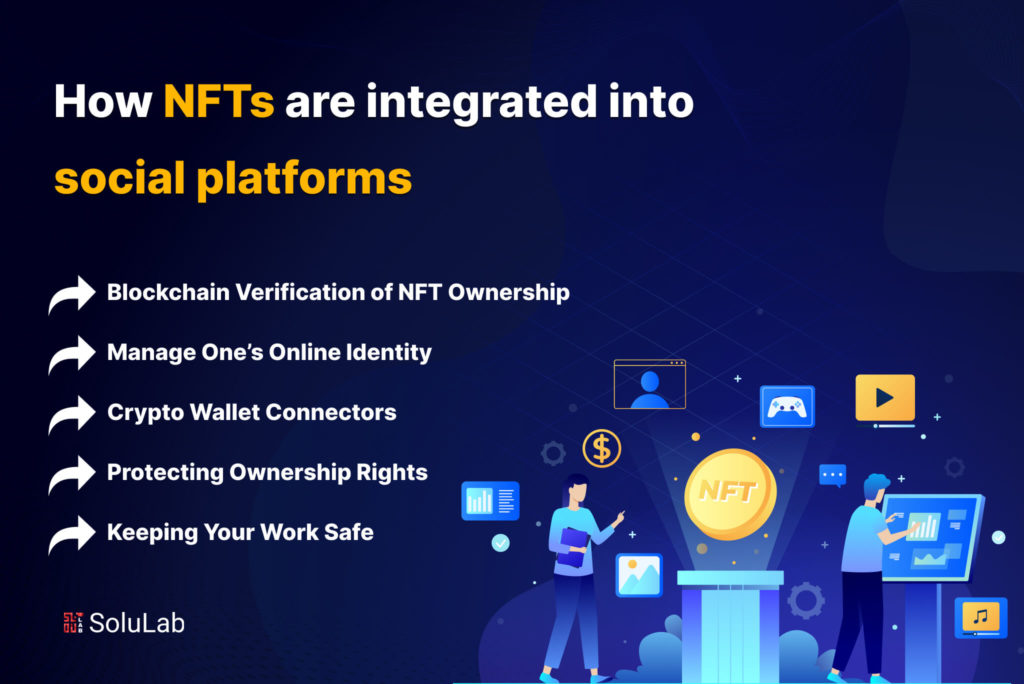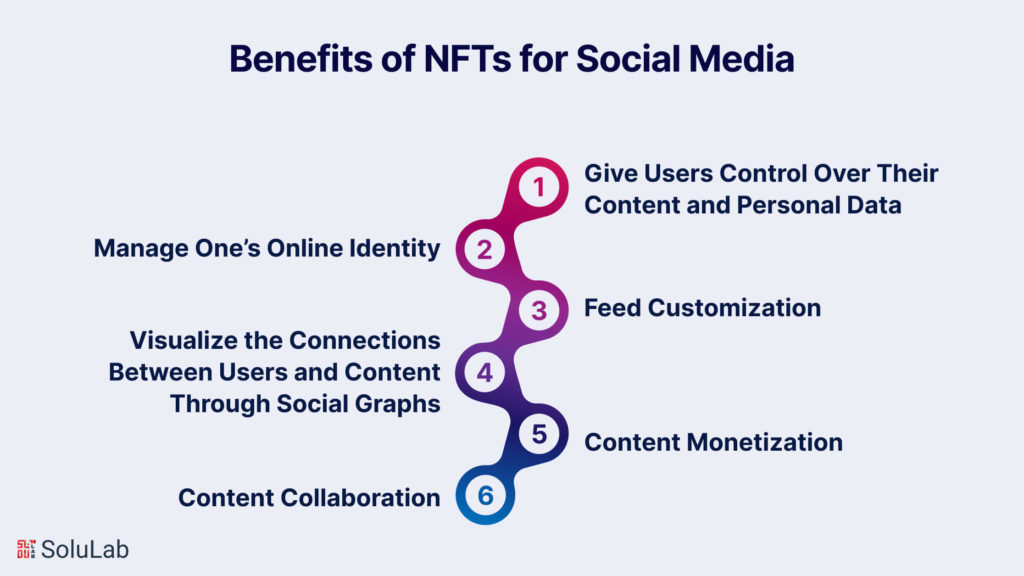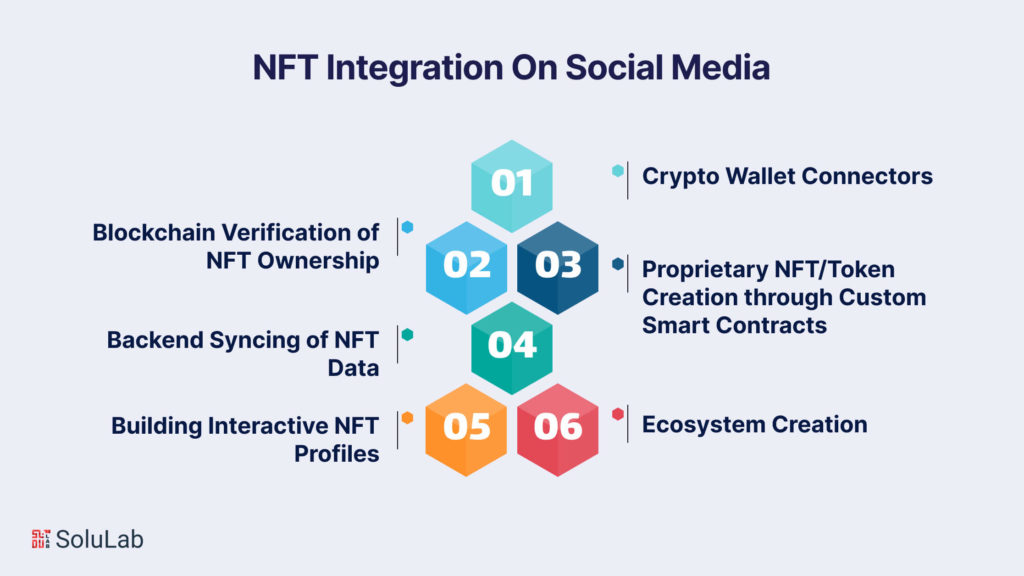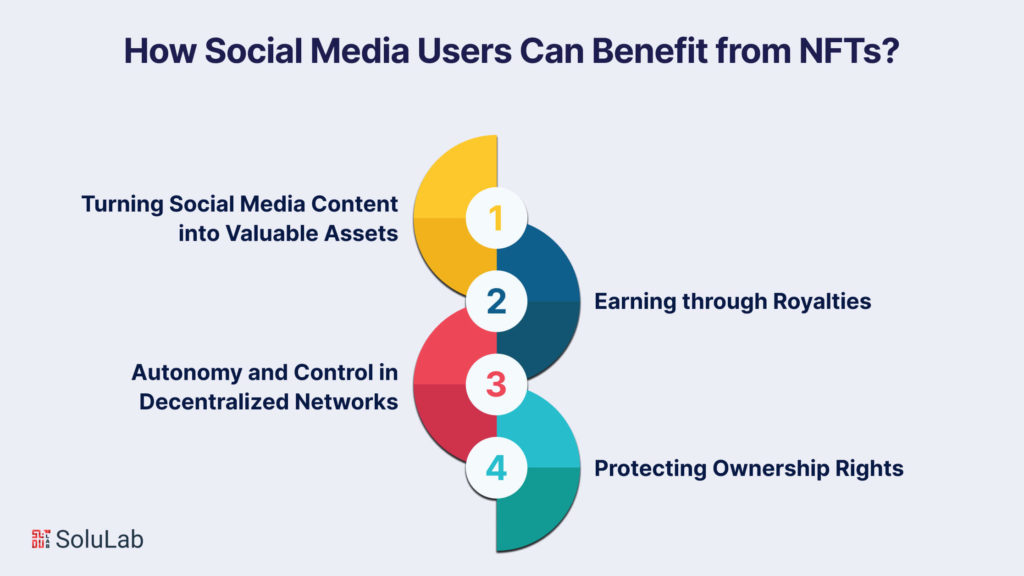
Last year, Twitter came up with a new feature– NFT profile pictures. After that, many people started using this unique digital artwork, backed by a non-fungible token, as their profile picture in a distinctive hexagonal shape. Clicking on the picture allows others to discover more about the artwork.
Why might someone be interested in NFTs in Social Media? Consider it like flaunting your status – a form of digital decoration. Shortly after, Reddit rolled out a similar feature. YouTube and Instagram have also expressed interest in exploring NFTs.
But the big question is: Why?
Well, the answer is simple- NFT brings a new and exciting way for social media platforms to monetize their content and actively engage the users. In this guide, we are going to explore the benefits of integrating NFTs into social media platforms and the process of doing it.
Understanding NFTs
NFTs (non-fungible tokens) are digital certificates that represent ownership of unique online assets like art, music, tweets, profile pictures, and more. Unlike cryptocurrencies, they cannot be directly exchanged for other tokens – each NFT has a distinct value based on factors like scarcity and demand. Recently, NFTs have exploded in popularity, with rare tokens selling for millions.
NFTs and Social Platforms
Social media has evolved significantly from the early days of MySpace and Facebook. Today, it serves as a central hub for communication, entertainment, and sharing information. The collaboration between NFTs and social media platforms has the potential to create a win-win situation.
NFTs benefit social media platforms in various ways, such as boosting engagement, expanding their user base, and creating new revenue streams. These digital tokens offer an easy method for content creators to make money from their content.
Simultaneously, NFTs give social media companies a tool to collect user data and use it to enhance customer service. These tokens contain unique information about the assets they represent, like the creator’s name or ownership history. This data enables social media companies to track user behavior, develop targeted services, and enhance the overall customer experience while monitoring NFT-related activities on the platform.
Moreover, social media companies can offer additional services related to NFTs, including creation, distribution, and trading. For instance, they could allow users to generate NFTs directly within their platforms and facilitate trading without relying on third-party exchanges. This approach provides users with more control over their assets and generates additional income for social media companies through fees.
Benefits of NFTs for Social Media

-
Give Users Control Over Their Content and Personal Data:
Integrating NFTs with social media allows users to have true ownership and control over their digital creations, whether it’s art, music, or any other form of content. Blockchain, the technology behind NFTs, enables decentralized control. Users, rather than the platform, have the keys to their NFTs, ensuring that they can decide how their content is used and who has access to it.
-
Manage One’s Online Identity
NFTs can be tied to a user’s online identity, providing a way to verify and authenticate their presence on social media platforms. This can help in reducing identity theft and impersonation issues. Through NFT-based identity, users can maintain a consistent online presence across different platforms, enhancing their online reputation and making it easier for others to identify them.
-
Feed Customization
By leveraging NFT technology, social media platforms can offer users the ability to customize their feeds based on their preferences. NFTs can contain metadata that helps algorithms curate content, ensuring that users see posts and updates that align with their interests and preferences. Users can use NFT-powered filters to control the type of content that appears in their feeds, creating a more tailored and enjoyable social media experience.
-
Visualize the Connections Between Users and Content Through Social Graphs
NFTs can be linked to a user’s social graph, visually representing connections and interactions between users and their content. These social media NFTs not only provide users with insights into their network but also foster a sense of community and collaboration. Social graphs powered by NFTs allow users to trace the origin and spread of content, fostering transparency and authenticity in the digital space.
-
Content Monetization
NFTs enable creators to tokenize their content, turning it into unique digital assets that can be bought and sold. This opens up new avenues for creators to monetize their work directly, without relying solely on platform advertising or sponsorship. NFTs can be programmed with smart contracts, allowing creators to receive a percentage of sales every time their NFT is resold. This creates ongoing revenue streams for content creators and allows them to benefit from the increasing value of their work in the secondary market.
-
Content Collaboration
NFTs can be designed to represent collaborative efforts, allowing multiple creators to contribute to a single NFT. Smart contracts can automatically distribute revenue among collaborators, streamlining the working process and sharing the benefits of the created content. Customizable NFTs for social media can be programmed to have shared ownership structures, where multiple individuals have a stake in the same digital asset. This encourages collaboration and collective ownership of creative projects.
Why Social Media Giants Love NFTs?
Even though you can’t create, buy, or sell NFTs directly on social media yet, how well artists promote their NFTs on these platforms matters for the success of their projects.
People who own NFTs often like to show them off on social media because it makes their NFTs seem more valuable. This gives social media companies that support cryptocurrencies an opportunity to connect with and keep new customers who are into NFTs.
Also, the social media platforms with the most influence in the NFT world can influence the development of Web 3.0. This new version of the internet is all about storing user data on blockchains.
Use Cases: NFTs in Social Media
-
Twitter
Twitter has been a leader in embracing NFTs on social media. In March 2021, the former CEO, Jack Dorsey, sold the first-ever tweet as an NFT for $2.9 million. Twitter is exploring ways to incorporate NFTs further, introducing a feature called “Super Follows.” This feature lets creators offer exclusive content to followers for a fee, including NFTs. Twitter has partnered with NFT marketplaces like OpenSea and Rarible, allowing users to buy, sell, and showcase digital tokens directly on the platform.
-
Instagram
Instagram, known for sharing photos and reels, is also getting into NFTs. It partnered with Nifty Gateway, allowing users to display their NFT collections on their profiles. Instagram is testing a “Collectibles” feature, allowing users to showcase their favorite NFTs on their profiles. This feature is in testing with a small group of creators and may roll out to a wider audience in the future.
-
Facebook/Meta
Meta, formerly Facebook, is integrating social media with NFTs, especially in its virtual reality platform, Horizon Workrooms. Users can use digital tokens to enhance their avatars. The acquisition of Giphy, which supports NFTs, may integrate NFT capabilities into Meta’s products. Meta is also considering allowing users to display their NFT collections on their profiles, potentially making NFTs more accessible to the general public.
-
Reddit
Reddit, a large online community, is exploring NFT integration. It announced a partnership with the Ethereum Foundation for an NFT-based applications competition. Reddit is testing NFT-based community points, allowing users to earn rewards for contributions and purchase unique subreddit tokens. It has its marketplace, Reddit NFT, where creators can mint and sell tokens.
- YouTube
YouTube, one of the world’s largest video-sharing platforms, has revealed plans to incorporate non-fungible tokens (NFTs) into its ecosystem. This innovative move allows content creators to offer exclusive items, such as limited-edition videos, unreleased music tracks, or personalized messages, directly to their fans. By leveraging NFTs, these digital tokens act as irrefutable proof of ownership, offering fans a distinctive and verifiable way to showcase their possession of unique digital content.
The upcoming “YouTube NFT Marketplace” feature is set to be seamlessly integrated with the platform’s existing suite of creator tools. This integration will empower creators to effortlessly mint and sell their NFTs directly on YouTube.
NFT Integration On Social Media: A Technical Overview

Here is how social media NFT integration works:
-
Crypto Wallet Connectors
The foundation of NFT integration begins with crypto wallet connectors. Users link their digital wallets to their social media accounts, allowing seamless interaction with NFTs. This connector establishes a secure bridge, enabling the transfer and display of NFTs directly within the social platform.
-
Blockchain Verification of NFT Ownership
To integrate NFTs into social media, platforms verify ownership through blockchain. This verification ensures the authenticity of NFTs ownership of the decentralized ledger, instilling trust, and preventing fraudulent activities.
-
Proprietary NFT/Token Creation through Custom Smart Contracts
Social media platforms create a unique user experience by implementing custom smart contracts for NFT/token creation. These contracts define the rules governing NFT interactions within the platform. Customization allows platforms to tailor NFT functionalities to align with their specific user engagement goals, fostering a more personalized and engaging user experience.
-
Backend Syncing of NFT Data
This integration process involves synchronizing NFT-related information, such as ownership, metadata, and transaction history, across databases and servers. The backend ensures that the user’s NFT collection is accurately reflected on their social profile, creating a cohesive and integrated digital presence.
-
Building Interactive NFT Profiles
Users can showcase their digital assets tokenization directly on their profiles, fostering a sense of identity and self-expression. The interactive aspect allows for features like likes, comments, and shares on specific NFTs, encouraging social engagement around digital collectibles.
-
Ecosystem Creation
NFT integration extends beyond individual profiles to create entire ecosystems within social platforms. Users can trade, gift, or even collaborate on NFT projects directly within the social environment. This ecosystem approach enhances user interaction, making social media not just a space for personal expression but also a hub for NFT-related activities and transactions.
How Social Media Users Can Benefit from NFTs?

-
Turning Social Media Content into Valuable Assets
NFTs offer a way for brands, marketers, influencers, and any social media user to turn their digital content into valuable assets. By converting digital content into NFTs, which are tied to crypto-based tokens, intangible artwork or photos gain tangible value. This tokenization trends enables the buying and selling of digital content, providing accessibility and liquidity. Assigning value through NFTs reflects the community’s consensus and scarcity, adding worth to the content.
-
Earning through Royalties
Blockchain-based social media platforms disrupt the traditional profit-sharing model. They eliminate intermediaries and platform fees, giving content producers more control over content distribution and allowing them to earn passive income. Social media NFTs enable creators to sell their work directly to a global audience, ensuring a larger share of the profits. Royalties can be programmed into NFTs, allowing creators to receive a percentage of sale profits each time their work changes hands.
-
Autonomy and Control in Decentralized Networks
Decentralized social networks empower users with more control and autonomy. Users benefit from censorship resistance, ownership of personal data, and improved control over user-generated content. In these networks, the community governs itself, preventing external entities from modifying or removing user-created content.
-
Protecting Ownership Rights
NFTs address copyright concerns by allowing content creators to retain ownership and exclusive rights to their work. Through a process called “minting,” social media users can assign NFT values to their digital creations, verifying their originality through the NFT source code. This ensures authentication and protects against value loss caused by digital reproduction. Blockchain’s immutability prevents the forgery or replication of digital files.
Who Benefits from NFT-based Social Media Platforms?
Influencers
- NFT-based social networks enable influencers to connect with their audience in a peer-to-peer manner.
- Influencers can respond creatively to fan requests by turning memorable photos into digital collectibles, forging a tangible connection.
Digital Artists
- NFT platforms help digital artists copyright their original work, providing a secure way to transfer digital creative assets.
- Artists can connect directly with audiences, retain ownership through royalties, and eliminate the need for intermediaries.
Brands
- NFTs offer brands opportunities in both digital and physical markets.
- Brands can create unique experiences, increase awareness, and drive revenue by using NFTs for digital art assets and ownership rights in promotional campaigns.
NFT Marketplaces and Social Media
The social media NFT marketplace platform allows influencers and users on social platforms to turn their content into unique digital assets using blockchain technology. This means they can sell videos, pictures, and other content directly to their audience, skipping the need for middlemen and making the process more direct and cost-effective.
In this marketplace, users can also participate in auctions, giving them a chance to bid on or buy NFTs. There are governance mechanisms in place to regulate the platform, and attractive rewards are offered to those who participate, whether they’re bidders, buyers, or fans of the artists. This helps increase the overall value of NFTs on social media.
The Social Media NFT Marketplace has lots of good things for creators and collectors.
-
Making Money for Creators
One great thing for creators is they can make money from their special digital stuff. They turn their digital things into NFTs, kind of like digital tokens, and put them up for sale on a marketplace. This way, creators can earn money for their cool ideas and hard work, whether it’s digital art, music, or anything else. The marketplace gives them a way to make money from what they create.
-
Keeping Your Work Safe
In the online world, it’s tough to keep your work safe from being copied. However, the Social Media NFT Marketplace uses blockchain tech to check that each NFT is one of a kind. This checking makes a kind of digital certificate to prove that a creator owns their work. It stops others from copying or sharing it without permission, keeping the creator’s rights safe.
-
Talking Directly to Fans
The marketplace also has a social side that helps creators get noticed and talk to their fans. Creators can share their stuff on social media, bringing in their fans and potential buyers. They can answer comments and messages and have real conversations with their fans. This direct talking helps creators get seen more and builds a community around them.
-
Unique Stuff for Collectors
For people who collect things, the Social Media for NFT Marketplace is a cool place to find unique digital stuff. Every NFT shows that someone owns a one-of-a-kind item or content, checked by blockchain tech. Collectors can buy these NFTs, adding unique digital things to their collections.
-
Investment Chances
The marketplace is also a way for collectors to invest. The value of NFTs can go up over time, which means they might be worth more later. Collectors can buy NFTs, keep them, and sell them later when the prices are higher. This chance for prices to go up lets collectors make money from their collections.
-
Chatting with Creators
Collectors can also talk directly to creators. They can follow their favorite creators, like and comment on their stuff, and send them messages. This direct talking makes collecting more fun and interesting.
Future of NFTs in Social Media
Social media with NFTs can change how we see digital ownership and creator earnings. For creators, NFTs offer a new way to make money from their content beyond ads. Fans can also feel a special connection to their favorite creators through unique digital items, making them more involved and loyal.
NFTs can also transform how we value digital stuff like art or music. They let us give a specific value to digital items, creating a new era of digital ownership and investment. Even something with little value before, like digital art, can become valuable using this technology.
However, there’s a worry about the environmental impact of NFTs. Since they use blockchain technology, they need a lot of energy, which has led to criticism. Despite this, the demand for social media with NFTs is growing. Creators and fans are exploring the possibilities, and more platforms are likely to use this technology soon. 
Take Away
Social media and NFTs have brought in a new time for digital ownership and earnings for creators. Social media platforms, from Twitter to TikTok, are finding ways to use digital tokens, giving new chances for creators and fans. Even though there are worries about the environment, we can’t ignore how NFTs can change the creator economy and digital asset value. As digital assets become more popular, we can expect exciting things to happen with NFTs and social media.
FAQs
1. What precisely is an NFT and how does it work?
An NFT is a unique tokenized digital asset representing ownership stored on blockchain. This provides proof of scarcity and authenticity.
2. How can NFTs enable monetization for social media creators?
NFTs give creators new abilities to directly sell their content to fans as digital collectibles. They also permit programming resale royalties.
3. What kinds of digital content are suited for NFT conversion?
Photos, videos, music, tweets, animated GIFs, digital artwork, branded collectibles, etc can potentially be turned into verified digital assets using NFTs.
4. In what ways do decentralized platforms empower social media participants?
Blockchain decentralization hands control back to creators over their content and data. There is enhanced autonomy, transparency, and censorship resistance.
5. Can NFTs help tackle plagiarism and theft on social platforms?
Yes, by establishing digital scarcity, provenance tracking, and assigning ownership rights to original creators via tokenization on blockchain.
6. Are there current working examples of NFT social networks?
A handful of pioneer NFT-powered social apps exist like Minds and Forest catering to artists, photographers etc. Many more are likely to come.





